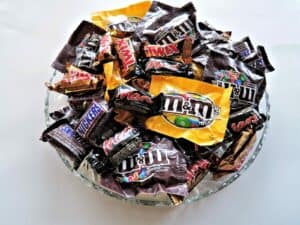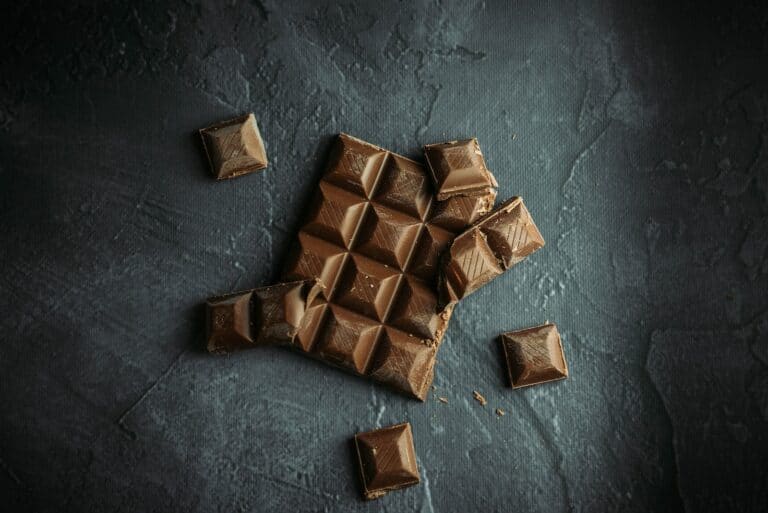Have you ever wondered, if can you eat expired chocolate? Well, you’re not alone. The answer: In most cases, yes. Chocolates typically have a long shelf life, giving you the chance to enjoy that sweet treat even past the expiration date. However, there are a few factors to consider, such as the type of chocolate and proper storage conditions, which affect its quality and safety for consumption.
Dark chocolate, milk chocolate, and white chocolate all have varying shelf lives. Generally, dark chocolate lasts the longest, while milk and white chocolates have shorter shelf lives due to their dairy content. When you eat expired chocolate, its quality might be compromised, but it doesn’t necessarily mean it’s unsafe to eat. An expiration date is merely a suggestion for when the chocolate tastes best. As you know, eating expired chocolate might cause temporary light stomach issues in some cases, but it’s typically safe to eat as long as it has been stored properly.
When it comes to properly storing chocolate, keep it in a cool, dry place, away from direct sunlight, and preferably in an airtight container. This will help extend its shelf life. If you’ve properly stored your chocolate and it’s past the expiration date, look for signs of spoilage, such as an off-putting odor, mold, or a white coating (known as fat or sugar bloom) before eating. If you don’t notice any of these signs and the chocolate doesn’t taste off, go ahead and indulge!
Understanding Chocolate Expiration Dates

So, can you eat expired chocolate? The answer lies in understanding chocolate expiration dates. When examining a chocolate bar, you’ll notice an expiration date or best before date printed on it. Contrary to popular belief, this date doesn’t necessarily mean the chocolate has gone bad or is unsafe to eat after that date. In most cases, chocolate products can last longer if stored properly.
To understand the shelf life of chocolate, let’s break it down into different categories:
- Dark chocolate: Due to its higher cocoa content and lower milk content, dark chocolate usually has a longer shelf life than milk or white chocolate. Dark chocolate can last anywhere from 1 to 2 years past its printed date if stored properly.
- Milk chocolate: This type of chocolate typically has a shelf life of 6 months to a year past its printed date.
- White chocolate: White chocolate has the shortest shelf life, lasting about 4 to 6 months past its expiration date.
However, remember that the actual shelf life of chocolate can vary based on factors such as added ingredients like nuts or fillings, temperature fluctuations, and storage conditions.
When it comes to eating expired chocolate, your senses can provide key information. Inspect the chocolate’s appearance, smell, and taste, looking for any off-putting signs. A white coating on the chocolate’s surface, known as sugar bloom or fat bloom, may develop due to exposure to moisture or temperature changes. While the chocolate’s texture might be affected, it’s still generally safe to eat.
Eating chocolate past the expiration date may result in a slight change in taste or texture. It’s essential to examine the chocolate for any mold, discoloration, or odd smells, as these could indicate the presence of harmful bacteria or the growth of other nasty substances. If you’re unsure, it’s best to take a small bite and assess its taste and texture before consuming a larger amount.
Some potential side effects of eating expired chocolate might include a slight stomach ache or temporary light stomach issues. However, it’s pretty rare to experience food poisoning from chocolate unless it’s been exposed to other harmful substances that contaminate it.
In summary, eating expired chocolate depends on several factors, including the type of chocolate and storage conditions. It’s always best to trust your senses and exercise caution when consuming old chocolate. To extend the chocolate shelf life, consider storing it in an airtight container, away from temperature changes and other foods with strong odors. Don’t let those expiration dates scare you too much. Remember, with proper storage, most chocolates can be enjoyed safely even after their printed date!
Health Risks Associated with Expired Chocolate

When it comes to answering the question, “Can you eat expired chocolate”, the answer isn’t as clear-cut as you might think. Your experience with eating expired chocolate mostly depends on factors such as the type of chocolate and its storage conditions. In most cases, eating expired chocolate poses minimal health risks, but there are still some factors to consider.
Dark chocolate, for instance, typically has a longer shelf life than milk chocolate and white chocolate. This is because it contains less milk solids, which can spoil faster. As a result, dark chocolate may still be safe to eat even if it’s past its expiration date. On the other hand, milk chocolate and white chocolate are more likely to show signs of spoilage due to their shorter shelf lives and higher milk content.
The most common issues with expired chocolate relate to changes in appearance, texture, and taste. These alterations occur due to the separation of cocoa butter and the development of fat bloom or sugar bloom. While these changes might make your chocolate taste less appealing, they generally aren’t harmful to consume.
However, there are some situations when it isn’t recommended to eat expired chocolate. If you notice any of the following signs, it may be better to discard the chocolate:
- Mold or fuzzy growth
- Off-putting odor
- Any signs of damage to the chocolate bars or packaging
As long as the chocolate has been stored properly, in a cool, dry place away from temperature fluctuations, and there are no obvious signs of spoilage, the risks associated with eating expired chocolate should be minimal, such as a slight stomach ache.
It’s important to note that some types of chocolate, like those containing nuts, dairy, or other perishable ingredients, have a higher risk of food poisoning due to the presence of harmful bacteria. In such cases, it’s best to err on the side of caution and avoid eating chocolate past its expiry date or sell by date.
For storing chocolate long-term, consider using an airtight container or resealable bags to preserve its quality. And remember, always check the best before date on your chocolate products to get an idea of their expected shelf life.
In conclusion, while eating expired chocolate isn’t always dangerous, it’s essential to ensure it’s free of any signs of spoilage to reduce any potential risks. And when you do decide to eat chocolate past its expiration date, it’s best to have a small bite first to gauge the taste and texture.
Changes in Taste and Texture
Can you eat expired chocolate? It’s a question many chocolate lovers have asked themselves as they reach for an old chocolate bar. In most cases, eating expired chocolate won’t make you sick, but you may notice some changes in the taste and texture of the chocolate. Let’s explore these changes in more detail.
Dark chocolate, milk chocolate, and white chocolate all have slightly different shelf lives, with dark chocolate usually having the longest. The expiration date on the packaging is often just a recommendation for when the chocolate will be at its peak quality. Unopened bars may last even longer than the sell by date suggests, while opened bars may have a shorter shelf life.
Chocolate stored improperly is more likely to experience changes in taste and texture. When storing chocolate, it’s best to keep it in a cool, dry place, away from other foods and any temperature fluctuations. An airtight container can also help prolong the chocolate’s freshness, keeping it away from moisture and other contaminants.
One change you might notice in expired chocolate is a white coating on the surface, often referred to as sugar bloom or fat bloom. Sugar bloom occurs when sugar crystals in the chocolate absorb moisture from the air and then recrystallize on the surface. Fat bloom, on the other hand, results from the cocoa butter in the chocolate separating from the cocoa solids and rising to the surface. While visually unappealing, these white coatings are not harmful to eat, and their presence won’t necessarily make the chocolate taste bad. However, it might affect the chocolate’s texture, making it grainy or crumbly.
Another possible change in taste is due to milk or nuts in the chocolate going bad. This is more likely to happen in milk chocolate and chocolate products with nuts, as these ingredients have a shorter shelf life than the chocolate itself. If you detect an off putting odor or the chocolate has a sour or rancid taste, it’s better to avoid eating it.
When deciding whether or not to eat expired chocolate, first check for other signs that the chocolate has gone bad, such as mold or an unusually strong smell. If the chocolate appears safe to eat, take a small bite and assess the taste. If the taste is off or the texture is unpleasant, it’s best not to eat the rest of the chocolate bar.
In conclusion, while eating expired chocolate may not always result in food poisoning or major health issues, you should still be cautious and pay attention to the chocolate’s appearance, taste, and texture. By being aware of these changes, you can make an informed decision on whether or not to indulge your sweet tooth with that old chocolate bar.
How to Properly Store Chocolate
When it comes to storing chocolate, there are a few things to consider. Proper storage can significantly extend the shelf life, making it less of a concern if you’re wondering “can you eat expired chocolate”. Keep these tips in mind to make sure your chocolate stays fresher longer.

Dark chocolate, milk chocolate, and white chocolate all have different storage requirements. Generally, dark chocolate has the longest shelf life, followed by milk chocolate, and then white chocolate. To help maintain freshness, you can store chocolate bars in an airtight container to protect them from humidity.
Ideal storage conditions for most chocolates include:
- A cool, dry place: Keep chocolate away from heat sources and direct sunlight. Aim for temperatures between 65°F and 68°F (18°C to 20°C).
- A stable temperature: Fluctuations and temperature changes can cause sugar bloom or fat bloom to occur, altering the taste and appearance of your chocolate.
- Away from strong odors: Chocolate can absorb odors from other foods, so it’s best to store it away from items with strong smells.
When it comes to expiration date, here’s a general idea of the shelf life for different types of chocolate:
Chocolate TypeUnopened BarsOpened BarsDark Chocolate2+ years1-2 yearsMilk Chocolate12-18 months9-12 monthsWhite Chocolate8-12 months4-6 months
For chocolate chips, the shelf life can be 2+ years if stored properly. A similar timeline applies to cocoa powder, while filled chocolates usually have a shorter shelf life of 6-9 months.
If you happen to eat expired chocolate, the most common outcome is a change in taste or texture, but it’s not always harmful. It’s important to note that while eating expired chocolate might not be detrimental to your health, it’s best to consume chocolate at its peak quality for the maximum enjoyment.
If you’re still questioning “is it safe to eat expired chocolate?”, pay close attention to the chocolate’s appearance and taste. Inspect it for sugar bloom, fat bloom, and off-putting odors. A white coating on the chocolate doesn’t necessarily mean it’s gone bad, but might suggest that it won’t taste as great as when originally purchased. Feel free to take a small bite and check if the taste has worsened. If you experience slight stomach ache or mild discomfort, consider avoiding eating more of the expired chocolate.
By following proper storage methods and being attentive to the printed date on your chocolate, you can ensure optimal quality and freshness, making it easier to determine if it’s still suitable to enjoy past its best before date.
Tips for Consuming Expired Chocolate Safely
Wondering if you can eat expired chocolate? In most cases, eating expired chocolate is not harmful, but it may not taste great. Keep in mind that different types of chocolate have various shelf lives. Here are some tips for consuming expired chocolate safely.
- Check the expiration date: Most chocolates have a printed expiration date or best before date. Just because the date has passed, it doesn’t necessarily mean the chocolate is inedible. Often, manufacturers use these dates to indicate peak quality rather than the last day of safety. Chocolate bars may still have some life left after the date has passed.
- Examine the chocolate’s appearance: Is there a white coating on the chocolate bar? Don’t worry. It’s not mold but rather sugar bloom or fat bloom. It occurs due to temperature fluctuations, and while it may affect the texture and taste, it won’t make you sick. Expired chocolate can still be used in chocolate recipes where the taste and texture aren’t as crucial.
- Give it a sniff: If you eat chocolate past its expiration date and notice it has an off-putting odor, this could indicate the presence of harmful bacteria or that the chocolate has gone bad. It’s best to toss it in the trash.
- Consider the type of chocolate: Dark chocolate, milk chocolate, and white chocolate have different guidelines for eating chocolate past the expiration. Dark chocolate typically has a longer shelf life than milk chocolate or white chocolate. Filled chocolates, chocolate chips, and chocolate with nuts have a shorter shelf life than plain chocolate bars.
- Take a small bite first: If you’ve decided to eat expired chocolate, take a small bite to see how it tastes. If it tastes fine, you can continue eating it cautiously. If you experience a slight stomach ache or temporary light stomach issues, stop eating it and switch to a newer bar.
- Store chocolate properly: Storing chocolate in a cool, dry place away from other foods and temperature fluctuations extends its shelf life. Keep it in its original packaging, an airtight container, or store chocolate in the refrigerator for optimal longevity. Storing chocolate correctly can help you enjoy it after the expiration date, but be aware of signs that it’s no longer safe to eat.
While eating expired chocolate may not taste as good as regular chocolate, it is generally safe to eat. Be cautious, take note of any changes in appearance or taste, and remember to store it properly to prolong its shelf life. Just because the expiry date has passed doesn’t mean you can’t still enjoy a chocolate treat!
Final Thoughts
So, can you eat expired chocolate? The answer is, for the most part, yes. Eating expired chocolate generally isn’t harmful, but its quality and taste might not be at their peak. Let’s recap some key points about eating expired chocolate:
- Dark chocolate has a longer shelf life than milk chocolate and white chocolate, which have a higher milk content and may spoil faster.
- Expiration date is not a definitive indicator of chocolate’s edibility; it refers more to peak quality. Most chocolate can be eaten past its expiration date, especially if it was stored properly.
- Look for signs like sugar bloom and fat bloom, which affect your chocolate’s appearance but are not indicators of harmful bacteria. Chocolate with such issues can still be eaten, although the taste may be slightly off.
- Taste test a small bite of the expired chocolate before consuming larger amounts. Although it’s rare for it to lead to severe food poisoning, some might experience temporary light stomach issues after eating expired chocolate.
Remember:
- Storing chocolate in an airtight container away from temperature fluctuations helps preserve its taste and quality.
- If the chocolate has a white coating, smells bad, or tastes rancid, it’s better not to consume it.
- Eating chocolate chips and filled chocolates follows different guidelines due to their shorter shelf life and additional ingredients, like nuts.
Whether you’re using expired chocolate for baking or satisfying a sweet tooth, as long as you’re storing your chocolate correctly and checking for any off-putting appearances or odors, you can likely enjoy it past its expiration date. But when in doubt, it’s always better to be safe than sorry.
